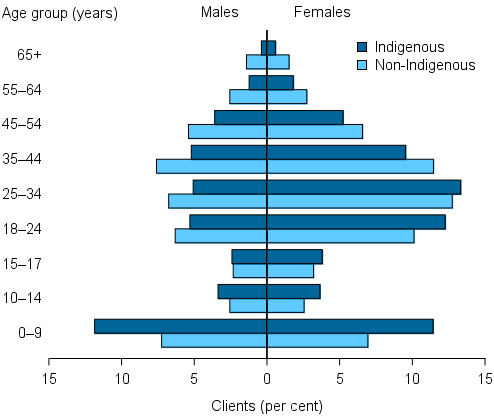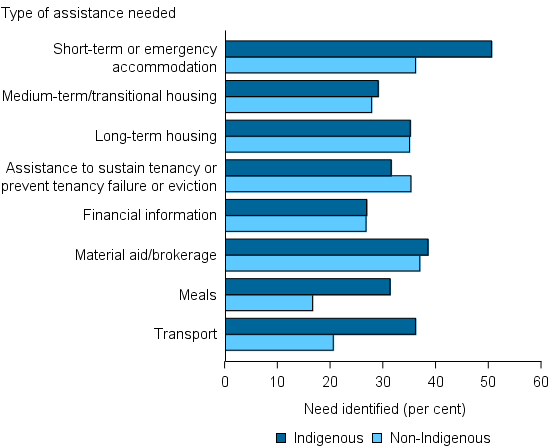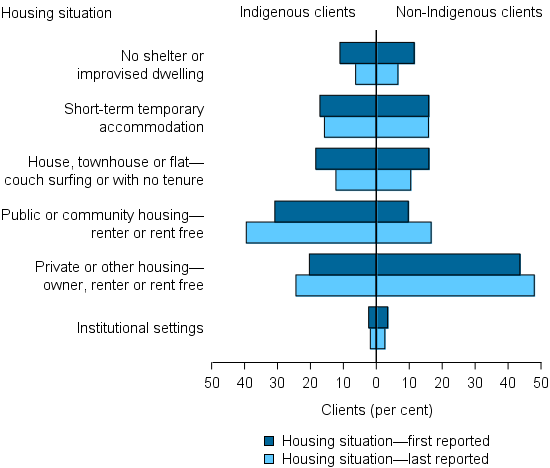Indigenous clients
Aboriginal and Torres Strait Islander people continue to be over-represented in both the national homeless population and as users of specialist homelessness services (see Clients, services and outcomes) [1]. Aboriginal and Torres Strait Islander people make up 3% of the Australian population, yet they made up 23% of those accessing specialist homelessness services in 2014–15: 53,301 clients. Indigenous status was not reported for 11% of SHS clients in 2014–15.
Indigenous clients: trends over time
The number of Indigenous clients has been steadily increasing since the beginning of the SHS collection in 2011–12. The key trends identified over these 4 years have been:
- The rate of service use by Indigenous clients has increased from 587 clients per 10,000 Indigenous people in 2011–12 to 693 per 10,000 in 2014–15.
- The gap between Indigenous and non-Indigenous rates of service use has been widening. Indigenous clients used specialist homelessness services at a rate of 8.7 times that of non-Indigenous clients in 2014–15, up from 7.8 times in 2011–12.
- After taking into account differences in population size, in 2014–15 Indigenous clients accessed services at the highest rate in Major cities. Previously highest rates were reported in Inner and Outer regional areas.
- The rate of service use by Indigenous clients living in Remote/Very remote areas has increased by the greatest margin over time; from 499 Indigenous clients per 10,000 population in 2011–12 to 689 in 2014–15. This is in contrast to non-Indigenous clients in the same areas where the rate decreased from 53 clients per 10,000 to 38 clients over the same time period.
- The proportion of Indigenous clients ending support in some form of public or private housing has improved. In 2014–15 around 40% of Indigenous clients assisted ended support in public or community housing compared with 35% in 2012–13.
| 2011–12 Indigenous |
2011–12 Non-Indigenous |
2012–13 Indigenous |
2012–13 Non-Indigenous |
|
|---|---|---|---|---|
| Number of clients (proportion of all clients where Indigenous status reported) | 43,642 (22%) | 157,227 (78%) | 46,607 (22%) | 160,740 (78%) |
| Rate (per 10,000 population) | 587 | 75 | 623 | 76 |
| Rate ratio | 7.8 | 8.2 | ||
| Remoteness rate (per 10,000 population) | ||||
| Major cities | 594 | 68 | 626 | 69 |
| Inner/Outer regional | 628 | 101 | 660 | 100 |
| Remote/Very remote | 499 | 53 | 551 | 54 |
| Rate ratio | ||||
| Major cities | 8.8 | 9.1 | ||
| Inner/Outer regional | 6.2 | 6.6 | ||
| Remote/Very remote | 9.4 | 10.3 | ||
| Housing situation at the beginning of first support period (all clients) | ||||
| Homeless: At risk of homelessness | 46%: 54% | 42%: 58% | 47%:53% | 44%: 56% |
| Living arrangement | ||||
| Lone person | 23% | 33% | 24% | 34% |
| Sole parent | 33% | 31% | 33% | 30% |
| Couple with child/ren | 14% | 13% | 14% | 13% |
| Couple without children | 5% | 5% | 6% | 5% |
| Other family | 18% | 11% | 17% | 10% |
| Other group | 6% | 8% | 7% | 8% |
| Main reason for seeking assistance (Top 4) | ||||
| Domestic and family violence | 24% | 23% | 22% | 21% |
| Housing crisis | 12% | 14% | 13% | 15% |
| Financial difficulties | 14% | 16% | 14% | 17% |
| Inadequate or inappropriate dwelling conditions | 13% | 9% | 15% | 11% |
| Proportion receiving accommodation (median (nights)) | 50% (21) | 35% (43) | 49% (21) | 36% (40) |
| Number of support periods (average per client) | 66,406 (1.5) | 241,357 (1.5) | 73,911 (1.6) | 271,119 (1.7) |
| Average (median) length of support (days) | 85 (34) | 83 (32) | 93 (40) | 87 (34) |
| Proportion of a client group with a case management plan | 65% | 58% | *64% | *56% |
| Achievement of all case management goals | 20% | 20% | 19% | 21% |
| 2013–14 Indigenous |
2013–14 Non-Indigenous |
2014–15 Indigenous |
2014–15 Non-Indigenous |
|
|---|---|---|---|---|
| Number of clients (proportion of clients who reported Indigenous status) | 49,615 (23%) | 167,288 (77%) | 53,301 (23%) | 173,955 (77%) |
| Rate (per 10,000 population) | 654 | 78 | 693 | 80 |
| Rate ratio | 8.4 | 8.7 | ||
| Remoteness rate (per 10,000 population) | ||||
| Major cities | 660 | 72 | 711 | 75 |
| Inner/Outer regional | 673 | 100 | 684 | 99 |
| Remote/Very remote | 613 | 40 | 689 | 38 |
| Rate ratio | ||||
| Major cities | 9.2 | 9.5 | ||
| Inner/Outer regional | 6.7 | 6.9 | ||
| Remote/Very remote | 15.3 | 18.0 | ||
| Housing situation at the beginning of first support period (all clients) | ||||
| Homeless: At risk of homelessness | 46%: 54% | 43%: 57% | 47%: 53% | 43%: 57% |
| Living arrangement | ||||
| Lone person | 23% | 33% | 22% | 31% |
| Sole parent | 35% | 32% | 35% | 33% |
| Couple with child/ren | 14% | 13% | 14% | 13% |
| Couple without children | 5% | 5% | 5% | 5% |
| Other family | 16% | 9% | 18% | 10% |
| Other group | 6% | 7% | 5% | 7% |
| Main reason for seeking assistance (Top 4) | ||||
| Domestic and family violence | 22% | 21% | 24% | 24% |
| Housing crisis | 14% | 17% | 21% | 21% |
| Financial difficulties | 12% | 16% | 10% | 14% |
| Inadequate or inappropriate dwelling conditions | 15% | 11% | 13% | 10% |
| Proportion receiving accommodation (median (nights)) | *48% (22) | *34% (43) | 47% (20) | 32% (42) |
| Number of support periods (average per client) | 79,110 (1.6) | 280,249 (1.7) | 87,018 (1.6) | 293,244 (1.7) |
| Average (median) length of support (days) | *89 (41) | *85 (36) | 82 (40) | 78 (35) |
| Proportion of a client group with a case management plan | *68% | *59% | 70% | 60% |
| Achievement of all case management goals | *22% | *23% | 24% | 25% |
Notes
-
Rates were directly age-standardised as detailed in the Technical information section.
-
Rate ratio is the Indigenous rate divided by the non-Indigenous rate.
-
* Indicates where previously published data have been revised to ensure consistent reporting over time. 2011–12 data were revised in December 2013 but not previously reported in this format.
-
The denominator for the proportion achieving all case management goals is the number of client groups with a case management plan. Denominator values for proportions are provided in the relevant national supplementary table.
Source: Specialist homelessness services Annual Reports 2011–12, 2012–13, 2013–14 and 2014–15.
In 2014–15 changes occurred in the way agencies are required to report 'main reason' and 'reasons for seeking assistance'. Comparisons over time should be made with caution as the reporting of housing crisis, financial difficulties and housing affordability stress may be inconsistent between agencies. See Technical information for further details.
Age and sex
1 in 4
Indigenous clients were children aged less than 10.
- When compared with non-Indigenous clients, Indigenous clients were younger (23% were children aged 0–9) and more likely to be female (62%) (Figure INDIGENOUS.1).
- Over half of all Indigenous clients (54%) were aged under 25 compared with 40% of non-Indigenous clients.
Figure INDIGENOUS.1: Clients by Indigenous status, by age and sex, 2014–15

Source: Specialist homelessness services 2014–15, National supplementary table INDIGENOUS.1 (702KB XLS).
Services needed and provided
- Over half of the Indigenous clients seeking assistance needed short-term or emergency accommodation (51%, or about 27,000) compared with 36% for non-Indigenous clients.
- Apart from 'short-term or emergency accommodation', 'meals' and 'transport', the need for other accommodation based assistance was broadly similar between Indigenous and non-Indigenous clients (Figure INDIGENOUS.2).
Figure INDIGENOUS.2: Clients, by Indigenous status and by most needed services, 2014–15

Note: Most needed excludes 'Other basic assistance'.
Source: Specialist homelessness services 2014–15, National supplementary table INDIGENOUS.3 (702KB XLS).
Housing outcomes
For clients with closed support periods:
- For Indigenous clients, the most common housing situation at the start of support was public or community housing (31%), compared with private or other housing for non-Indigenous clients (44%).
- For Indigenous clients, the most common housing outcome at the end of support was public or community housing (39%, or over 13,000) followed by private rental (24%, or over 8,000) (Figure INDIGENOUS.3). For non-Indigenous clients, the most common housing outcomes at the end of support were private rental (48%) followed by public or community housing (17%).
- Compared with the previous year, there has been an improvement in housing outcomes for Indigenous clients. In 2014–15 around 2,500 (or 9%) more clients ended support in public or community housing and fewer clients remained in short term or emergency accommodation.
Figure INDIGENOUS.3: Clients with closed support, by Indigenous status and by housing situation at the beginning and end of support, 2014–15

Source: Specialist homelessness services 2014–15, National supplementary table INDIGENOUS.4 (702KB XLS).
Reference
- Australian Bureau of Statistics (ABS), 2012. Census of population and housing: estimating homelessness, 2011. ABS cat no. 2049.0. Canberra: ABS.


